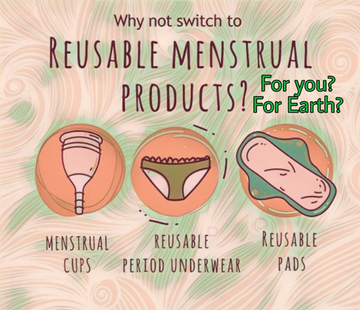‘Green’ Menstruation in Bhutan: For health, climate and beyond – Dema Wangchuk
Gone are the days when menstrual hygiene information and products were unavailable but still half of the population, those menstruating in Bhutan, are neglected, without any dialogue to advance legislation and protect menstrual health with the provision of free menstrual products.
The bare minimum that the government could do is to exempt sales tax for menstrual products needed by females. Menstrual products are deemed to be luxurious products for female reproductive health and must be paid for. Yet condoms – important to protect sexual health and avoid unwanted pregnancies – are distributed free, despite sex being a choice.
A menstruating person generates about 150kgs of menstrual waste – disposable pads/tampons – in their lifetime. A rough calculation estimates 814,840kgs of waste being produced from 244,452 females in the country annually. There is a huge carbon footprint in making these products and the used ones either end up at landfills (takes 500-800 years to decompose) or are burned: injurious to the environment either way. These products also contain harmful chemicals like dioxins (cause cancer) that are unsafe for the menstruator’s health over a long period of use; rather like smoking cigarettes for a long time, but at least cigarettes come with a warning.

I’ve realized that this guilt trip we experience for producing menstrual waste is unnecessary because we aren’t committing a sin. With the limited available means to meet our menstruation needs and the little attention to the issue, you can only expect the burning of used pads or stray dogs eating them from the garbage. However, menstruators should switch to greener options – reusable pads, period panties and menstrual cups if they’ve right information and means. Amanda Laird of Heavy Flow, once said, “If you’ve a choice, you’ve to make the choice to consider the environment”.
However, affordability and willingness also matters – no one should be pressured into using reusable products if they can’t afford and aren’t willing: it’s a personal choice. Some might find them too laborious to wash or are scared at the sight of blood, or a menstruator with disability has difficulty using it and other valid reasons. We should always keep disposable options for those who need them while advocating for reusable menstrual products.
Reusable pads are like the common disposal pads that many use, except that they’re made of cloth which is leak-proof and washable: just like the times when older generations, including many millennials used a piece of cloth, the ‘khasha’, although that used to leak and was unhygienic. The period panty is similar to the usual underwear, but it absorbs menstrual blood. These are suitable for those who are uncomfortable with the other popular option, the cup. A menstrual cup comes in a bell shape, which is flexible and inserted inside the vagina during a period to collect blood. It’s made of either rubber or silicone: I suggest silicone, as it’s proven to be medically safe.
Reusable pads and period panties have to be changed every 2-5 hours, which translates to about 5-12 of these per day and 15-36 if period lasts for 3 days (less if they’re dried early for next use, as these have to be dried out in air/sun). Now, there’re period panties that one can wear up to 8 hours too but might be expensive. These pads and panties can last for approximately 2-5 years or more depending on the quality/usage while menstrual cups can last for 15 years and you only need one.
I’ve used all of them but have cupverted (i.e. converted to using cup) for over a year and it’s the most convenient, as you can keep the cup inside for as long as 8-12 hours (not more) depending on your period flow. This means that you don’t have to be bothered by your period when you’re at school or work and spares you from the hassle of changing and disposing off pads/panties; it feels like non-period days. Once you get home, you can empty the cup, and rinse it before reinserting it, and sleep without worrying. Between every cycle it’s important to sterilize the cup in boiling water for few minutes: the only extra work of a ‘cupvert’.
A study conducted by Ministry of Education and UNICEF on Menstrual Hygiene Management in 2018 revealed that 44.7% of respondents (1,526 schoolgirls and 202 nuns) skipped school from 1-4 days each month. The reasons were pain, discomfort, dirty toilets and lack of sanitary pad disposal options. Even at work, women and girls face similar situations. Sometimes, this obstructs their performance at school and work. Some female students even drop out of school because of such avoidable problems; it’s timely for the provision of affordable green menstrual products to female students.
Anyone can use reusable pad and panty. However, people can misunderstand menstrual cup; that young females and those adult females who never had sex can’t use it for the practical reason of being a virgin. This is false based on scientific revelation that there is no such thing as virginity because hymen can break in other ways like dancing and sporting. It should be of no importance whether it stays intact or not. Anyone who menstruates has an opening in the hymen large enough to allow the blood flow in the first place. Thus, anyone starting their period can use the cup.
With any menstrual product there is no zero risk, but it’s important to learn that these green menstrual products rarely pose any health risk, if used properly. These plastic free period products have benefits beyond health and climate; one’s self esteem will increase, will have more time to do productive things, less to no absenteeism, increase in one’s performance at school or work, and other advantages.
We had Red Dot campaign which encouraged menstruators to dispose off their used pads/tampons in a small white wrapper with a red dot on it, as a way to curb the disposal issue. The burning question remains: where did/do all of these go? While it was a good initiative, we’ve to start taking a sustainable approach to menstruation hygiene management: one that’ll guarantee safe menstrual health and fight climate change/preserve the environment.
Personally I prefer menstrual cup as I can’t think of being a burden on the earth. For those already using or willing to try the cup or other reusable pads and panties, you’re/will be helping the environment. For those who aren’t interested, I suggest opting for organic disposable pads, which are biodegradable and will still ensure you’ve a ‘green’ menstruation.
In the face of Covid-19, such green menstrual products will prove to be more valuable especially if we go on a lockdown. This could also be a life-saving intervention for those under period poverty (inadequate access to menstrual hygiene tools and knowledge) in the country.
In addition to all the menstrual struggles that females go through, there is also a cultural/religious taboo that prohibits females to enter certain parts (called ‘goenkhangs’) of temples because of their menstruating capacity. Although cultural change may take longer time, we can at least start with ensuring a safe and green menstrual health management for menstruators which will also conserve the environment. Thus, Bhutan, the only carbon-negative country, as an environment and climate champion should be the first country in the world to provide ‘’green’ menstrual products for free.
As young people of Bhutan who menstruate, we’ve the right to dignity and right to health which includes the right to free menstrual products. It’s not a privilege but a healthcare product that is needed for a natural biological function.
The article is written by Alumni ASAP Youth Champion and vocal SRHR advocate from Bhutan, Dema Wangchuk and was originally published in https://kuenselonline.com/






